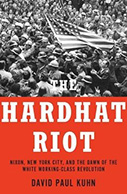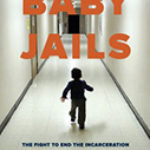The Hardhat Riot: Nixon, New York City, And The Dawn Of The White Working-Class Revolution

Author: David Paul Kuhn
Publisher: New York: Oxford University Press, 2020. 416p.
Reviewer: Jerald Podair | May 2021
The death of the New Deal Democratic voter and the birth of the Donald Trump voter occurred on the same day. On May 8, 1970, at Federal Hall in Lower Manhattan’s Financial District, a mob of construction workers from the nearby World Trade Center building site charged into an anti-Vietnam War demonstration, fists, elbows, knees, and weaponized tools flying, wreaking havoc on those they deemed disloyal to the country and flag they loved. Cheered on by sympathetic office workers and largely unconstrained by a police force that was depending on one’s perspective either physically overwhelmed or in concert with the attackers, the so-called “hardhats” planted an American flag on the statue of George Washington that stood on the Federal Hall steps, replacing a Vietcong flag that had waved there minutes earlier. After beating and injuring scores of student protesters, the hardhats marched north to City Hall, where they assaulted more students, called for the head of New York’s left-liberal mayor, John Lindsay, and demanded the raising of the building’s American flag, which Lindsay had ordered lowered to half-staff to memorialize the casualties of the Kent State shootings four days earlier. Fearing a hardhat invasion of the building itself – the workers were at the front door – a deputy mayor meekly complied. Twelve days later, 150,000 hardhats and other blue-collars returned to City Hall in what became known as “Workers’ Woodstock,” replete with patriotic chants, signs and songs, displays of reverence for the flag, and angry denunciations of privileged political radicals and their high-placed abettors, including liberal politicians like Lindsay who they viewed as hostile to traditional American verities.
In Washington, President Richard Nixon was watching with great interest. With his administration under attack in Congress, the media, and the streets after his decision to send troops into Cambodia, expanding a war he was ostensibly winding down, Nixon saw an opportunity emerging from the crisis. The demonstrating workers were union members, a powerful Democratic constituency. For decades, Nixon had sought to reinvent the Republican Party in the image of “the people,” thus reversing the configuration that had held since the Great Depression and that cast the Democrats with the masses and the Republicans with the classes. In the 1940s and early 1950s, Nixon had challenged the assumptions behind that configuration when during the Alger Hiss affair and in his career-saving “Checkers” speech he associated the GOP with populist sensibilities arrayed against Democratic elites. But it had nonetheless been an uphill struggle, and despite Nixon’s victory in the 1968 presidential election, gained in part through the support of those he would soon refer to as the “Silent Majority,” as of May 8, 1970 the Democrats were still the party of the lunch pail-toting, hardhat-wearing, union card-carrying white working man.
That allegiance, however, was primarily economic in nature. The issues motivating the hardhats massed in front of Federal and City Halls, in contrast, were cultural. They included not just a love of country and flag, but a set of values surrounding family, home, neighborhood, and faith that underpinned their American identities. With antiwar protestors burning American flags and calling openly for Vietcong victory, and liberal politicians appearing to bend over backwards to justify and even honor their behaviors, Nixon conducted a raid on the opposition camp. On May 12, only four days after the mayhem in the Financial District, he paid a visit to AFL-CIO headquarters, where he met with its president, George Meany – a lifelong Democrat – and offered a show of support for the hardhats. Two weeks later, in the wake of Worker’s Woodstock, Nixon received the leaders of New York City’s 200,000-strong building trade unions, who presented him with an honorary “hard hat” emblazoned with his name. He happily accepted, then spoke of his respect for “labor leaders and people from Middle America who still have character and guts and a bit of patriotism” (252). They were Nixon’s people now.
In 1972, breaking with tradition, George Meany’s AFL-CIO did not endorse the Democratic candidate for the presidency, George McGovern. The delegates to the Democratic National Convention that year had earned ten times the proportion of graduate degrees as the voting population as a whole, and twice the average income. By then, too, John Lindsay, coldshouldered in the GOP, had become a Democrat. Nixon’s landslide reelection victory in 1972 owed much to a new Republican constituency: white union members, who gave him almost 60% of their votes. Nixon also won almost 70% of low-to-middle income whites. Ronald Reagan’s oft-quoted quip that he had not left the Democratic Party but that it had left him had come to life on a mass scale, and the road to Donald Trump’s Republican Party was open and inviting. It all started on a spring day in Lower Manhattan when thousands of men in hardhats walked off their jobs at the half-completed World Trade Center and took to the streets for flag and country, changing the direction of American politics in the process.
This story, told by David Paul Kuhn in The Hardhat Riot: Nixon, New York City, and the Dawn of the White Working-Class Revolution, is in many respects a familiar one. But it has never been told like this before. With the aid of previously deep-buried Federal Bureau of Investigation and New York City Police Department files, Kuhn has reconstructed the minute-by-minute and often second-by-second events of the riot with a granular vividness that approaches the cinematographic. His prose transmits the tactile and immediate feel of the past. Its effect is immersive. Good historical writing narrates the process of change over time. Great writing places us in the midst of history as its arc shifts before our eyes. Kuhn’s work belongs in the latter category.
This valuable book also commends itself as a warning to the present from the recent past. The New York trade union workers, not to mention the members of the city’s police force, constituted a version of the “deplorables,” circa 1970, in the eyes of left-of-center public officials like John Lindsay, as well as student radicals, their professors, and the emerging young urban professional, or “Yuppie,” class. The violence meted out by the hardhats in the streets of the Financial District that day in May was indeed deplorable. But their concerns about the direction of the nation – the abuse of the right of protest, the flouting of traditional forms of authority, the retreat from patriotism, the upsurge in criminal activity, the decline of the industrial economy, and the inequitable burdens of societal change – were not deplorable at all. Many Democratic Party leaders viewed the concerns of the hardhats as thinly-disguised expressions of racism as well as what today would be termed unearned white privilege. To some degree, they were correct. But there was also much that was legitimate and genuine in what the hardhats had to say, and if Democrats would not listen, then Republicans, including Richard Nixon, Spiro Agnew, Ronald Reagan, and George W. Bush, would be glad to do so. In 2016, the ballots of the children and grandchildren of the hardhats helped elect Donald Trump, and came within a few thousand well-placed votes in a handful of states of reelecting him in 2020. “It didn’t take a college degree to know when your folkways were being belittled, to know when you were being patronized, to recognize the desecration of what you deemed solemn,” writes Kuhn of the hardhats of 1970 (277). Today, as traditions shatter, institutions waver, and statues topple, we can only hope that history does not rhyme.
Jerald Podair, Professor of History and Robert S. French Professor of American Studies, Lawrence University


